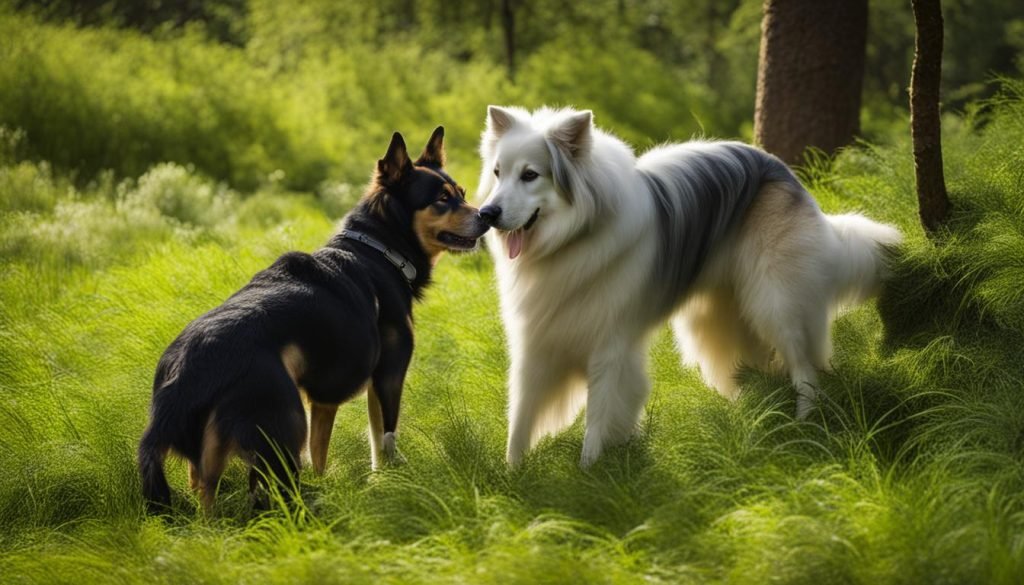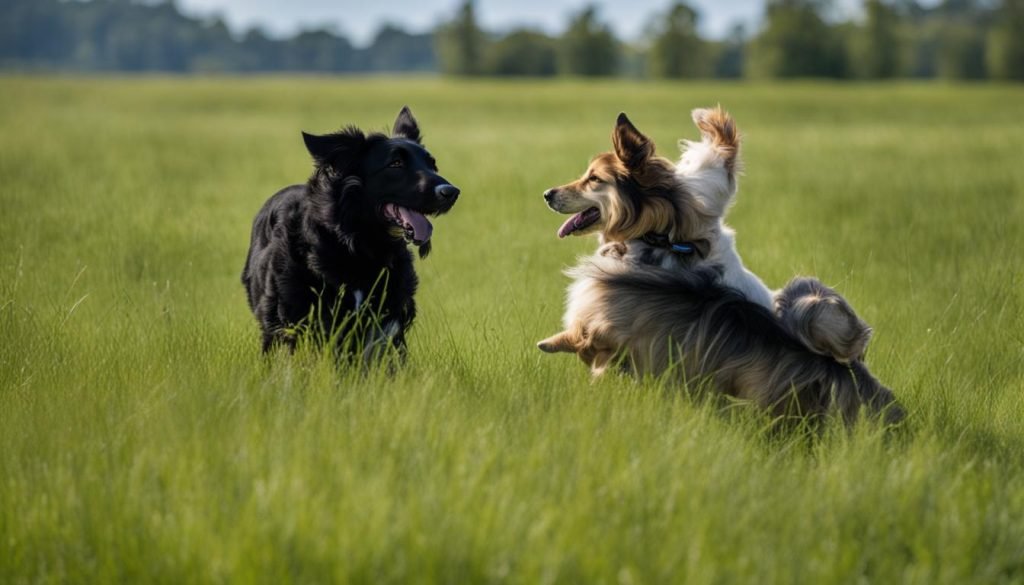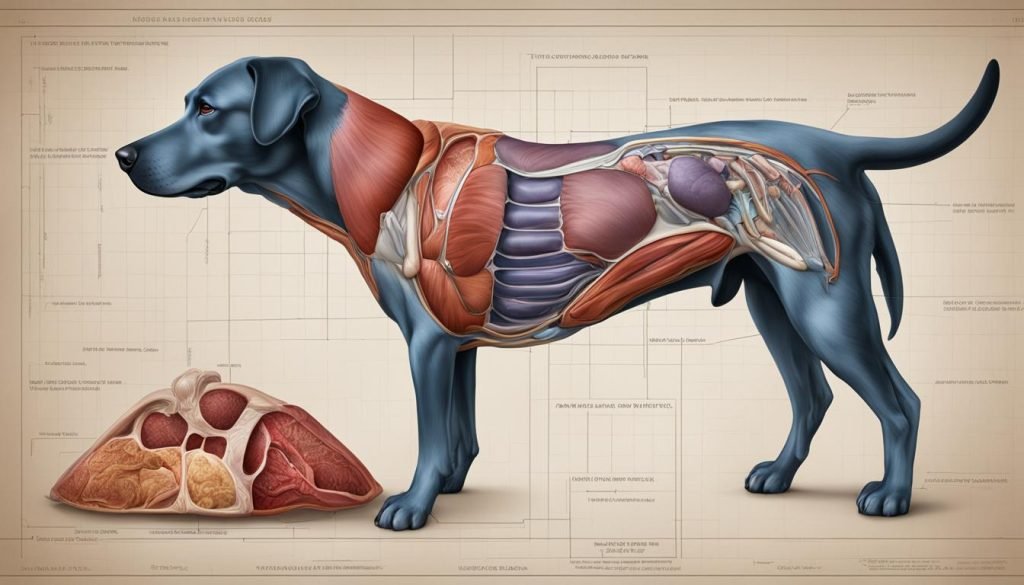How Do Dogs Mate? – Dogs Reproduction Explained
Canine reproduction is a fascinating topic that encompasses dog mating behaviors, the breeding process, and the anatomy of dogs’ reproductive systems.
In this comprehensive guide, we will delve into the world of canine reproduction, exploring everything from the sexual behavior of dogs to the process of pregnancy and whelping.
By the end of this article, you will have a thorough understanding of the factors involved in responsible dog breeding and a deeper appreciation for the wonder of canine reproduction.

Key Takeaways:
- Canine reproduction encompasses dog mating behaviors, the breeding process, and the anatomy of dogs’ reproductive systems.
- A solid understanding of dog sexual behavior is crucial in comprehending how dogs mate.
- The mating process involves copulation between male and female dogs.
- Familiarizing ourselves with the male and female reproductive systems is crucial in comprehending the process of reproduction.
- Responsible dog breeding requires careful consideration of factors such as genetic health and temperament.
Understanding Canine Sexual Behavior
Before we can dive into the mechanics of dog mating, it’s important to understand the sexual behavior of dogs. Canine sexual behavior can be complex, and understanding it can help ensure successful mating and breeding.
Dogs are polygamous and copulate with multiple partners. The estrus cycle (heat) is the phase in which the female dog becomes sexually receptive and can mate. The length of the estrus cycle varies, but it usually lasts between 2 to 3 weeks. During this time, the female emits specific scents that attract male dogs, and they engage in courtship rituals.
Estrus Cycle
The estrus cycle is the period in which female dogs become receptive to mating. There are four stages of the estrus cycle:
- Proestrus: The first stage of the estrus cycle lasts for approximately 9 days. The female dog’s vulva begins to swell, and she may show signs of increased restlessness and attract male dogs.
- Estrus: This is the phase in which the female dog is fertile and can mate. It lasts for approximately 9 days, but it can vary. The female dog’s vulva is swollen, and she may show signs of increased restlessness and attract male dogs.
- Diestrus: The final phase of the estrus cycle lasts for approximately 60 days. The female dog’s vulva returns to its normal size, and pregnancy can occur during this time.
- Anestrus: This is the resting phase of the estrus cycle, and it can last between 2 to 4 months.
Dog Quiz
How well do you know dogs? Test your knowledge below!

Courtship Rituals
Courtship rituals are the behaviors that male and female dogs exhibit during the estrus cycle. These rituals are essential to the mating process, as they allow the male dog to identify a receptive female and give the female an opportunity to evaluate the male before mating.
Male dogs will often sniff the female’s genital area to determine if she is in heat. They may also lick and nuzzle the female to show affection. Female dogs may display receptive behavior by standing still and holding their tail to one side or raising their hindquarters toward the male dog.

By understanding the intricate sexual behavior of dogs, breeders can identify the right time for mating, ensure successful coupling, and increase the chances of producing healthy offspring.
The Mating Process
The mating process between dogs is a complex and fascinating series of behaviors and physical actions that culminate in copulation and potentially, the production of offspring.
Before any physical interaction occurs, dogs typically go through several stages of behavior to establish compatibility and prepare for mating. These behaviors, known as courtship rituals, vary between breeds and genders but generally involve posturing, vocalizations, and sniffing. Once compatibility is established, the male dog usually mounts the female dog from behind, and copulation begins.
The actual act of copulation is a relatively short process, lasting anywhere from a few seconds to several minutes. During this time, the male dog’s penis becomes erect and is inserted into the female dog’s vagina, allowing for the transfer of sperm from the male to the female. Once copulation is complete, the dogs will usually separate, and the male dog will typically go about his business while the female dog may begin preparing for pregnancy.
It is important to note that not all instances of dog mating result in pregnancy, and several factors can affect the likelihood of successful breeding. These factors include the age and reproductive health of the dogs, as well as the timing of the mating in relation to the female’s estrus cycle.
Breeding Dogs: Tips for Success
If you are considering breeding dogs, it is essential to take several factors into account to ensure a successful outcome. Here are a few tips to keep in mind:
- Choose healthy dogs with favorable breed characteristics
- Time the mating correctly in relation to the female’s estrus cycle
- Consult with a veterinarian to ensure the health and wellness of both dogs
- Provide a safe and comfortable environment for the mating and any resulting pregnancy

“The mating process between dogs is a delicate dance of behavior and physical actions that, when done correctly, can result in offspring with favorable breed characteristics and genetic health.”
Breeding dogs can be a rewarding and educational experience, but it is essential to approach the process with care and consideration for the animals involved. By understanding the mating process and taking necessary precautions, breeders can increase their chances of successfully producing healthy offspring.
Reproductive Anatomy of Dogs
Understanding the reproductive anatomy of dogs is crucial to comprehend the process of how dogs mate. The male and female reproductive systems play essential roles in the mating process.
Male Reproductive System
The male reproductive system consists of the penis, testes, epididymis, prostate gland, and accessory glands. The primary reproductive organ in males is the testes, which produce sperm, and the male hormone testosterone. The sperm mature in the epididymis and travel through the ductus deferens, which merge with the urethra in the penis. During ejaculation, the sperm and the secretions of the accessory glands mix in the urethra and exit the body through the penis.

Female Reproductive System
The female reproductive system includes the ovaries, fallopian tubes, uterus, cervix, and vagina. The ovaries produce eggs (ova) and secrete hormones such as estrogen and progesterone. During the estrus cycle, which occurs every six months approximately, the mature eggs pass into the fallopian tubes to await fertilization. The uterus receives the developing embryos and provides them with nutrients to grow. The cervix is the entrance to the uterus and the place where sperm enter the female’s reproductive tract during mating. The vagina connects the cervix to the outside of the body and serves as the receptacle for the penis during copulation.
Overall, the male and female reproductive systems work together to ensure successful mating, fertilization, and pregnancy.
Breeding Dogs: Factors to Consider
Breeding dogs is a significant responsibility that requires careful consideration of various factors.
Genetic Health
One of the most important considerations when breeding dogs is genetic health. Breeders should conduct tests to ensure that dogs do not have genetic disorders that can be passed on to their offspring. For example, breeds such as the Bulldog and the Boxer are prone to hip dysplasia, a genetic ailment that can cause severe pain and mobility issues.
By conducting genetic tests and carefully selecting breeding pairs, breeders can improve the overall health of a breed and reduce the likelihood of genetic disorders in future generations.
Temperament
Another important consideration when breeding dogs is temperament. Breeders should select dogs with favorable temperaments, as these traits can be passed down to their offspring.
For example, Labrador Retrievers are known for their friendly and outgoing personalities, and these traits have made them one of the most popular breeds in the United States. By selecting dogs with favorable temperaments, breeders can ensure that their offspring are well-suited to life as a pet or working dog.
Breed Standards
Breeders should also consider breed standards when selecting dogs for breeding. Breed standards define the physical characteristics and behavior of a breed and are used to maintain consistency within the breed. By breeding dogs that meet breed standards, breeders can improve the overall quality and reputation of the breed.
However, it is essential to remember that breed standards should never be prioritized over genetic health and temperament. While physical characteristics are important, they should not come at the expense of a dog’s well-being or personality.
Pregnancy and Whelping
Once the mating process has been completed, the female dog enters the stage of pregnancy. It is important to keep in mind that not all matings result in pregnancy. In dogs, the gestation period typically lasts between 63 to 65 days, although it can vary by a few days depending on individual factors.
During pregnancy, it is crucial to provide the expectant mother with proper nutrition and care. This includes a healthy diet, regular exercise, and frequent vet checkups to monitor the health of both the mother and the developing fetuses.
As the due date approaches, several signs indicate the mother is about to give birth. These include a decrease in body temperature, restlessness, and nesting behavior. It is important to have a whelping box ready, which is a safe, comfortable place for the mother to give birth.
The whelping process can take several hours or even a day or two, depending on the size of the litter. It is important to observe the mother and provide assistance if necessary, such as helping to remove the placenta or cleaning off the newborn puppies. The puppies should be checked for health and vitality and nursed by the mother as soon as possible.
It is crucial to provide proper care for the mother and puppies during the postpartum period. This includes ensuring the mother has proper nutrition, rest, and care for any complications that may arise. The puppies should be monitored for proper growth and development and receive necessary vaccinations and veterinary care.
Responsible Dog Breeding and Conclusion
As we have explored in this comprehensive guide, canine reproduction is a complex process that requires careful consideration and responsible practices. One major issue that arises from irresponsible breeding is overpopulation, which can lead to overcrowded shelters and even the euthanasia of healthy animals.
The importance of responsible dog breeding
Responsible dog breeding involves considering various factors, such as genetic health, temperament, and breed standards. It also means avoiding breeding dogs with known health problems or genetic defects that could be passed on to their offspring.
The impact of overpopulation
Overpopulation is a serious issue that affects not only dogs but also cats and other animals. It is estimated that millions of animals enter shelters each year, with many of them being euthanized due to lack of space or resources. By practicing responsible dog breeding and spaying and neutering our pets, we can help reduce the number of unwanted animals and improve their overall welfare.
The role of spaying and neutering
Spaying and neutering are important practices that can help control pet overpopulation. Spaying involves removing the uterus and ovaries of female dogs, while neutering involves removing the testicles of male dogs. These procedures not only prevent unwanted litter but also have health benefits, such as reducing the risk of certain cancers and behavioral problems.
As responsible pet owners, we must ensure that our dogs are healthy, happy, and well-cared for. By practicing responsible dog breeding and spaying and neutering our pets, we can make a positive impact on the lives of animals and combat the issue of overpopulation. Let’s work together to create a better world for our furry friends!
More About Dogs:
- What Do Dogs Eat? Your Guide to Healthy Canine Diets
- How Long Do Dogs Live? Dog Life Expectancy
- 15 Facts About Dogs You Didn’t Know
- Dog Quiz: How Well Do You Know Dogs?
Frequently Asked Questions
How do dogs mate?
Dogs typically mate through a process known as copulation, which involves the male dog mounting the female dog from behind. The male’s reproductive organ, called the penis, is inserted into the female’s reproductive tract, allowing for the transfer of semen and fertilization of the female’s eggs.
What are some common dog mating behaviors?
Dogs display various mating behaviors, including mounting, sniffing, licking, and vocalizations. These behaviors are part of the courtship process, in which both male and female dogs communicate their readiness to mate and establish a connection before engaging in copulation.
How can I tell if a female dog is ready to mate?
Female dogs go through an estrus cycle, which is commonly known as being “in heat.” Signs that a female dog is ready to mate include changes in behavior, a swollen vulva, a bloody discharge, and increased friendliness toward male dogs. It is important to consult with a veterinarian for confirmation and guidance.
What happens during the mating process?
The mating process involves several stages. It begins with the male and female dogs being introduced to each other and engaging in courtship behaviors. Once the female is receptive, copulation occurs. The male’s penis becomes erect and is inserted into the female’s vagina. Ejaculation then takes place, allowing for the transfer of semen and potential fertilization of the female’s eggs.
What is the reproductive anatomy of dogs?
Dogs have complex reproductive anatomy. In males, the reproductive system includes the testes, epididymis, vas deferens, and penis. Females have ovaries, fallopian tubes, uterus, cervix, and vagina. These organs and structures play crucial roles in the process of reproduction and mating.
What factors should I consider when breeding dogs?
Breeding dogs should be approached with careful consideration. Important factors to consider include genetic health, temperament, and adherence to breed standards. Responsible breeders prioritize the overall well-being and quality of the offspring while avoiding potential health issues associated with irresponsible breeding practices.
What should I know about dog pregnancy and whelping?
Dog pregnancy, also known as gestation, typically lasts for around 63 days. During this time, the female dog may experience physical and behavioral changes. It is important to provide proper care, nutrition, and veterinary check-ups throughout the pregnancy. Whelping, or giving birth, requires a clean and quiet area for the mother and newborn puppies.
Why is responsible dog breeding important?
Responsible dog breeding is essential to address the issue of overpopulation and promote the well-being of both dogs and their offspring. It involves considerations such as genetic health, temperamental traits, and ethical breeding practices that prioritize the long-term welfare of the breed. Additionally, spaying and neutering are crucial in preventing unplanned litters and reducing the number of dogs in shelters.







